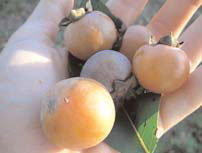Reading Our Region
Essays from a Regional Writer
 Susan Charkes enjoys hearing and telling stories, especially those involving the environment, farming, and sustainability in our region. Discover her poetic view of the outdoors and be inspired to visit the places she describes. Learn more about Susan, her writing, and even hear her podcasts at www.susancharkes.com.
Susan Charkes enjoys hearing and telling stories, especially those involving the environment, farming, and sustainability in our region. Discover her poetic view of the outdoors and be inspired to visit the places she describes. Learn more about Susan, her writing, and even hear her podcasts at www.susancharkes.com.
Sample these selected writings:
| Featured Items: |
Fruit on the Floor
by Susan Charkes
Harvest Moon rises perfectly round and plump, glowing amber. It looks close enough to touch. But as soon as you reach for it, it slips out of your grasp, away up into the trees.
There, little moonlets hang. Perfectly round and plump, glowing amber. They look good enough to eat. But pluck one from the branch, bite down: it's lemontart, bitter and hard, not sweet.
No these moonlets must set before being eaten.
Lower your gaze and hunch down, among the dried leaves and tufts of grass pocketed with root crevasses. Down here, away from heaven's gaze, lie our native tree-fruits of autumn: crabapple, pawpaw, persimmon. Fallen fruits, whose fall signals that the time is right. Fruit on the floor is the ripest of all.
 Crabapples on the tree are greenish-yellow, with the fresh-faced sheen of youth. As they mature they put on a rosy blush and a cloudy matte finish freckled with harmless wax-dwelling fungi. The apples' natural wax coating (it shines when you rub it on your clothes) keeps water from either penetrating or evaporating through the skin, preventing rot while keeping the fruit-juiciness that makes the apple appetizing.
Crabapples on the tree are greenish-yellow, with the fresh-faced sheen of youth. As they mature they put on a rosy blush and a cloudy matte finish freckled with harmless wax-dwelling fungi. The apples' natural wax coating (it shines when you rub it on your clothes) keeps water from either penetrating or evaporating through the skin, preventing rot while keeping the fruit-juiciness that makes the apple appetizing.
Appetizing, that is, if you like sour apples. Despite its common name, the "sweet crabapple" – the only crabapple native to our area –bears tart, sour fruit. Good for jellies, and for cider, and for tossing across a field, but for not for sweet loveliness.
It is the crabapples imported from Asia and Eurasia that are sweet. Luckily for the forager, the many varieties of crabapples merrily hybridize, natives with imports alike. You never know what you are in for. Maybe the apple you pick up will sit sweetly on your tongue, and maybe not. It's a crab shoot.
You'll find crabapple trees, like most members of the rose family, in sunny spots – roadsides, old field thickets, fencerows. Pawpaws, though, flourish down low, in floodplains where it's cool and moist and shady. Once a pawpaw tree finds a good spot, it seriously settles in, spreading by underground stems to clone itself over and over. A pawpaw patch is a wondrous thing to find, for here the forager will be rewarded with armfuls of exotic fruit.
Tucked under wide, teardrop-shaped leaves as long as a forearm, pawpaw fruits develop into greenish cylinders a few inches long. Hard and yellowish on the small tree, there is no point in plucking them: not till cool autumn nights arrive will the fruits will ripen and fall. As the skin of the fallen fruit sags, darkens, and wrinkles, the inside softens.
Peel off the skin to uncover an orangeyellow, pulpy, spoonable mass. A bit of banana, a bit of apple, a bit of vanilla: the pawpaw fruit seems tropical. Indeed, it is the northern-most member of the custardapple family.
In the pulp lie a half dozen flattish mahogany seeds in clear membranous sacs. Although opossums, raccoons and squirrels gobble up pawpaws, they leave the seeds where they've found the fruit, which gives the tree no reproductive advantage over its own cloning. Some researchers hypothesize that pawpaws evolved very large fruits and seeds to be eaten by very large mammals, such as the mastodon, which would disperse the seeds in scat. Deprived of the service of these animals, extinct since the last Ice Age, the pawpaw has been left to its own devices.
Persimmons, too, are probably Ice Age relicts, and they now spread by cloning rather than by seed dispersion. Unlike crabapples and pawpaws, though, which are small, spreading understory trees, the persimmon – a member of the ebony family – shoots up tall and straight. If you spot its distinctive square-fissured bark in autumn, look up into its canopy. There are the bright orange, plum-sized fruits. But the two-toned, tapering persimmon leaves point straight down, as if saying, "Look below!"
Reach up to a low branch and pull off a fruit. It feels good in the hand, soft and edible. “Look below!” say the leaves. You take a bite. “Ohhh. We warned you!” say the leaves. The still-hanging persimmon fruit packs a secret weapon. One bite dries your mouth faster than Rosie's quicker-picker-upper. Persimmon is the quicker-puckerer.
But just wait. Wait till the fruit has plopped from the tree onto the forest floor, where it languishes like a half-spent balloon. Grab it, if you can, before the local woodland creatures do. Ripe persimmon has a papaya-like consistency, and a flavor all its own: a bit like pear, a bit like apricot, and much that is unlike anything else.
Fruit on the floor goes against everything they tell you. They tell you to want a clean, shiny, round fruit, easily plucked from its neat pyramidal pile under the bright lights, tasting just like what you expect it to taste like. Fruit on the forest floor is hard to find. And when you do find it, it's mud-spotted, fungi-speckled, fall-dented; misshapen, pock-marked, pitted. You never know if it'll be ripe, and even if it is ripe, every fruit tastes a little different.
Compared with the perfect ideal of the Harvest Moon, fallen fruits fall short. But the moon is perfect in a moonly way. Fall fruits attain perfection not by looking like the moon, full and round and luminous, but by looking like fruit, ripened by the fullness of time.
© Susan Charkes 2007

